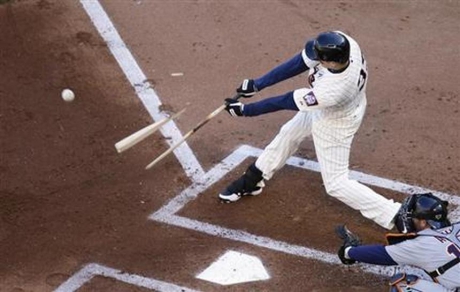Reports
You are here
Home runs, broken bats and climate change

October 19, 2021
In the 7th inning of the National League Champion Series the Atlanta batter swung hard at a Julio Urias fastball. His bat shattered lengthwise and the jagged barrel cartwheeled toward the Dodger pitcher.
It was the 3rd such broken bat in a single game. Each time broken bats turned into dangerous projectiles. In 2010, Chicago Cub player Ty Colvin was speared in the chest by the barrel of a broken maple bat while running from 3rd to home; his lung was punctured and he missed the rest of that season. Broken bats have also led to near-death injuries to spectators, and for that reason major league parks, as of 2017, feature netting behind home plate and down both base lines to protect fans.
The players’ union has asked MLB to extend the netting from foul pole to foul pole in every contract negotiation since 2007, but so far the owners have refused.
Broken bats are not a new thing, but the way these bats are shattering, and the frequency with which it is happening is new. And the danger they present is greater.
Historically, most baseball bats have been made of northern white ash, a hard wood that is also resilient, light and fairly pliable. But the forests of North America are now filled with skeletons, large dead ash trees, victims of the rapid spread of an invasive pest called the emerald ash borer. Prolonged cold winters used to keep the number of ash borers in check. But with warming temperatures resulting from climate change, the insects spread uncontrolled, and the northern white ash is following the majestic elm on the path to extinction.
So pro ball players have switched to bats made of rock maple wood, especially since 2000. The maple bats are heavier, have a smaller “sweet spot” and it is harder to control the direction of the hit. But they have a lot more “pop” if you hit them in the right spot, resulting in a lot more home runs.
They are also more brittle and when they break, as they do more often than the old ash bats, they tend to break lengthwise producing jagged spears.
The game of baseball has changed a lot over the years. In 1955, the year of my birth, major leaguers hit a total of 2,224 home runs. In 2019, before the pandemic shortened season, they hit 6,776 homers. As the number of homers has risen so have strikeouts. In 1955 there were 10,803 whiffs; in 2019 there were 42,823.
Not all those changes are bad. Some fans love the spectacle of the home run blast. And not all those changes are simply due to the change of wood for bat manufacture. Home run hitters get paid big bucks, even if the downside is a lot of strikeouts. But the changes in batting style and training are in part to take advantage of a heavier bat with more pop.
Elite level baseball is a game that inevitably contains some risks. But the risk from a shattered bat is an avoidable one. It is just a matter of time before a splintered maple bat takes the life of an infield player or baserunner. In 2010, when Colvin was injured, there were calls to outlaw the maple bat. But the prospect of fewer homers led the poohbahs who control the pro game to ignore the calls. Besides, the ash trees were fast disappearing. The alternative is the metal bat which is used at the college level, but that represents a major change in the game that team owners will not adopt willingly.
So the next time you see a player with a .200 batting average hit a 400 foot home run, or your favourite shortstop sidestepping a shard of bat whirling at his head, think of the innumerable ways in which climate change is changing our world for the worse.
Section:










